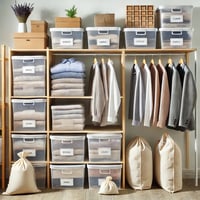Creating a custom closet can seem like a luxury, but it's an investment in organization,...
The Cost of Custom Closets - How to Design Within Your Budget
A custom closet is often considered a luxury, but it doesn’t have to come with a hefty price tag. Whether you're dreaming of a grand walk-in or simply want to maximize a reach-in space, you can create a custom closet tailored to your needs without breaking the bank. The key is understanding the factors that influence the cost and knowing where to spend and where to save.
In this blog, we’ll explore how to approach custom closet design with an eye on your budget, covering cost factors, design tips, and how to make smart choices to get the best value.
Understanding the Costs of Custom Closets
The cost of a custom closet can vary significantly based on a variety of factors. Here are the key elements that impact pricing:
Size of the Closet
The size of your closet is one of the biggest factors affecting cost. Naturally, larger closets will require more materials and labor, increasing the overall price. Walk-in closets will generally cost more to customize than reach-in or wardrobe closets due to the space and features involved.
Tip: If you're working with a limited budget, start by determining how much space you actually need. Sometimes, rethinking the layout of your existing closet and eliminating clutter can save you from the expense of a larger custom design.
Materials
The materials you choose play a significant role in the cost of your custom closet. Options range from inexpensive wire shelving systems to luxurious solid wood cabinetry. Your choice of finishes, hardware, and accessories will also impact the final price.
Low-Cost Materials:
- Wire shelving: Affordable and practical, but less visually appealing.
- Laminate: Offers a clean, modern look at a reasonable price.
Mid-Range Materials:
- MDF (Medium Density Fiberboard): A durable, versatile material that can be finished to look like wood at a lower cost.
- Veneers: Provide the look of real wood without the price tag of solid wood.
High-End Materials:
- Solid wood: The most luxurious and expensive option, offering timeless elegance and durability.
- Glass or mirrored doors: Add a premium feel to your closet but come with a higher price.
Tip: Mixing materials can help reduce costs while still giving your closet a high-end look. For example, you could use laminate for the structure and splurge on a few wood accents or upgraded hardware.
Customization Level
The level of customization will also influence the cost. Off-the-shelf closet systems are much cheaper than fully custom-built options. However, custom designs allow you to make the most of your space by tailoring every inch to your specific needs.
Pre-Fabricated Systems:
- These systems are designed to fit most standard closet spaces and come at a much lower cost than custom designs. They are often adjustable and can be installed as a DIY project.
Semi-Custom Designs:
- Semi-custom systems are built to order but may use pre-manufactured components. These are more affordable than fully custom options and still allow for some personalization.
Fully Custom Closets:
- These are designed and built to your exact specifications, offering complete control over layout, materials, and finishes. Naturally, this is the most expensive option.
Tip: If you're on a budget but want the look of a custom closet, consider a semi-custom design. You can achieve a tailored feel by using pre-made systems but selecting specific accessories or finishing touches that suit your style.
Accessories and Features
Custom closets often include a variety of accessories to enhance organization and storage. While these features can be useful, they can also add up quickly. Here's a breakdown of common accessories and their impact on your budget:
Basic Accessories:
- Hanging rods
- Shelving
- Baskets and bins
Mid-Range Accessories:
- Pull-out shoe racks
- Jewelry organizers
- Belt and tie racks
- Custom lighting (e.g., LED strips, motion-activated lights)
- Glass display cases
- Built-in ironing boards or laundry hampers
Tip: Prioritize accessories based on what will actually improve your closet's functionality. Avoid spending on features you won't use regularly, and instead focus on items that help solve your specific storage challenges.
Labor and Installation
Labor costs can vary depending on whether you opt for a DIY project or hire professionals. Installing pre-fabricated systems yourself is a great way to save on labor, but if your closet requires more complex construction, it's often worth the investment to hire experienced installers.
Tip: If you choose a semi-custom or fully custom option, ask your closet company if they offer free installation or bundle the cost with the design. Some companies offer promotions or discounts for installation, especially during certain times of the year.
Designing a Closet Within Your Budget
Now that you understand the various factors that impact the cost of a custom closet, let’s discuss how you can design a space that fits within your budget, no matter how much you plan to spend.
Start with a Plan
The first step in any successful custom closet project is to have a clear plan. Before you start shopping for systems or contacting a designer, consider the following:
- What are your storage needs? Make a list of what you need to store, such as clothing, shoes, accessories, or seasonal items.
- How often do you access the closet? If it's a space you use daily, focus on functionality. If it's for storage, consider prioritizing shelves and bins.
- What is your aesthetic? Do you prefer a minimal look, or are you aiming for something more luxurious?
Tip: By clearly outlining your goals, you can avoid unnecessary spending on features that don’t serve your specific needs.
Break Your Project Into Phases
If you're working with a limited budget but have long-term plans for your closet, consider breaking the project into phases. Start with the basics—shelving, rods, and hanging space—and add accessories or custom features as your budget allows.
Tip: Focus on the areas that will make the biggest impact first, such as installing double hanging rods to maximize space or adding a few shelves to clear up clutter.
Shop Sales and Discounts
Closet systems and accessories often go on sale during certain times of the year. Look for seasonal sales at home improvement stores or online retailers. You can also find discounts on discontinued items or buy second-hand from home goods resale websites.
Tip: If you have your heart set on a higher-end closet system, waiting for a sale can allow you to upgrade while staying within your budget.
Get Multiple Quotes
If you're considering a custom-built closet, don’t settle for the first estimate you receive. Shop around and get quotes from multiple contractors or closet companies. You may be surprised by the variations in pricing, and some companies may offer better deals or be willing to match competitors’ rates.
Tip: Be upfront about your budget when consulting with designers. They can often suggest alternatives or cost-saving ideas to help you achieve your vision without overspending.
Designing a custom closet within your budget is entirely possible if you focus on your needs, make informed choices about materials and features, and prioritize functionality. Whether you're going the DIY route with affordable organizers or investing in a fully custom design, the key is to plan carefully and stay mindful of where your money is going. With the right approach, you can create a custom closet that fits both your space and your budget perfectly.
Serving the Greater Boston Area with Expert Home Organization Services & Custom Closet Organization
At The Organized You, we offer personalized home organization services throughout the Greater Boston Area, including Wellesley, Dover, Needham, Newton, Medfield, Walpole, and beyond. Whether you need help decluttering, optimizing your closets, or creating a functional home office, we’re here to design systems that work for you. Learn more about our services in Wellesley, Dover, Needham, Newton, Medfield, and Walpole, and schedule your free consultation today!


